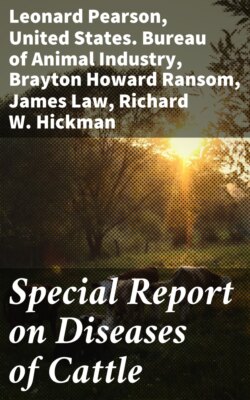Читать книгу Special Report on Diseases of Cattle - Lowe - Страница 78
На сайте Литреса книга снята с продажи.
ОглавлениеThe subject of poisonous plants is an important one and is of especial interest to those using the western stock ranges, for it is probable that there is no other single cause producing so many fatalities. In this article only a few of the more important plants are treated in a brief way, for an extended treatise would be necessary if the subject were to be handled adequately. Further information should be sought in the more elaborate publications. Many of the American poisonous plants have been treated in bulletins issued by the United States Department of Agriculture.
Treatment for plant poisoning.—Remedies given by the mouth in most cases fail to give relief to cattle affected by poisonous plants. The material of the poisonous plants in the first stomach is not very largely affected by a remedy given as a drench. If any beneficial result is effected, it must be on the material which has already passed into the fourth stomach, so that to get any real antidotal result the remedy must be given repeatedly in order to meet the alkaloid poisons as they are passing through the fourth stomach. While certain substances like tannic acid and potassium permanganate are the logical antidotes for plant poisons, in practical application they are very disappointing in the treatment of ruminant animals. Reliance must be mainly on prevention and upon such remedies as will increase elimination. A laxative or purgative is always helpful, and for this purpose Epsom salt may be given in pound doses, or linseed oil in doses of 1 or 2 pints. In some few cases special remedies can be given as is indicated below.
It is well to bear in mind that cattle while grazing freely in good pasture are not likely to eat poisonous plants to any extent. If these same plants are gathered and thrown in a pile, the animals, through a kind of pernicious curiosity, may eat them with disastrous results. This has frequently happened when freshly cut branches of cherry, yew, oleander, and other plants have been thrown where dairy cattle could get at them.
